I. Outlook
1. Macroeconomic Summary and Future Predictions
Last week, the U.S. stock market experienced significant volatility. On February 19, the three major U.S. stock indices closed slightly higher, with the S&P 500 index reaching a new all-time high; however, on February 21, all three indices fell sharply, with the Nasdaq dropping over 2%. The market reacted sensitively to a series of economic data, and investors maintained a cautiously optimistic attitude towards economic growth prospects and monetary policy direction. In the near future, investors need to closely monitor changes in economic data, policy dynamics, and geopolitical factors to make informed investment decisions.
2. Market Changes in the Cryptocurrency Industry and Warnings
Last week, Bitcoin's price continued to fluctuate within a narrow range. Some believe that the Bitcoin price trend has become complex, with increased trading difficulty, and high-level bulls are no longer entering, waiting for a pullback or breakout. For example, on February 21, Bitcoin's price approached a trend line, and the market remained focused on whether it could achieve a genuine trend reversal. If there are no positive stimuli this week, the crypto market may face further correction risks.
3. Industry and Track Hotspots
The Layer 1 public chain Mango Network, which links EVM & MoveVM, secured a $13.5 million investment from well-known institutions such as AINFRA and KUCOIN; Polychain Capital led the investment in the hybrid execution network Fluent, which connects EVM, SVM, and WASM chains; Kaito is a cryptocurrency search engine powered by ChatGPT, aimed at revolutionizing crypto research and investment through artificial intelligence, and is now live on Binance and Coinbase.
II. Market Hotspot Tracks and Potential Projects of the Week
1. Performance of Potential Tracks
1.1. How Mango Network, a Layer 1 public chain linking EVM & MoveVM, secured a $13.5 million investment from well-known institutions like AINFRA and KUCOIN
Introduction
Mango Network is a Layer 1 blockchain platform designed to address challenges in Web3 applications by combining EVM and MoveVM compatibility. It aims to provide developers and users with a secure, modular, and high-performance infrastructure.
Mango aims to be the most accessible smart contract platform, empowering developers to create outstanding user experiences in Web3. To welcome the next billion users, Mango offers developers a variety of tools to fully leverage the powerful capabilities of the Mango blockchain. The Mango Software Development Kit (SDK) will enable developers to build in a borderless environment.
Mango meets application demands through horizontal scaling. As the processing capacity of Mango validators increases by adding working nodes, the network capacity grows proportionally, maintaining low gas fees even during peak network traffic. This scalability feature sharply contrasts with the bottleneck designs of other blockchains.
Rich on-chain asset support enables new applications and economic models based on utility, without solely relying on artificial scarcity. Developers can implement dynamic NFTs that can be upgraded, packaged, and grouped according to application needs, such as updating avatars and customizable items based on gameplay changes. This capability enhances the in-game economy, as the behavior of NFTs is fully reflected on-chain, making NFTs more valuable and providing a more interactive feedback loop.
Multi-VM Omni-Chain
Mango Network combines OPStack and MoveVM to create a complete on-chain blockchain network that supports cross-chain communication and pushes technological boundaries.
The network adopts a two-layer architecture, with Mango Move as the L1 layer ensuring security, and OP-Mango as the L2 layer enhancing transaction speed and reducing costs, thus achieving efficient performance.
Mango Network is designed flexibly, supporting multi-virtual machine operations, providing developers and users with a wide range of application scenarios and optimized user experiences.
Multi-Virtual Machine Full-Chain Infrastructure Network
Mango Network integrates MoveVM and EVM to create a multi-layer network that supports cross-chain operations, allowing developers to leverage the advantages of both virtual machines to provide a broader range of services and application scenarios.
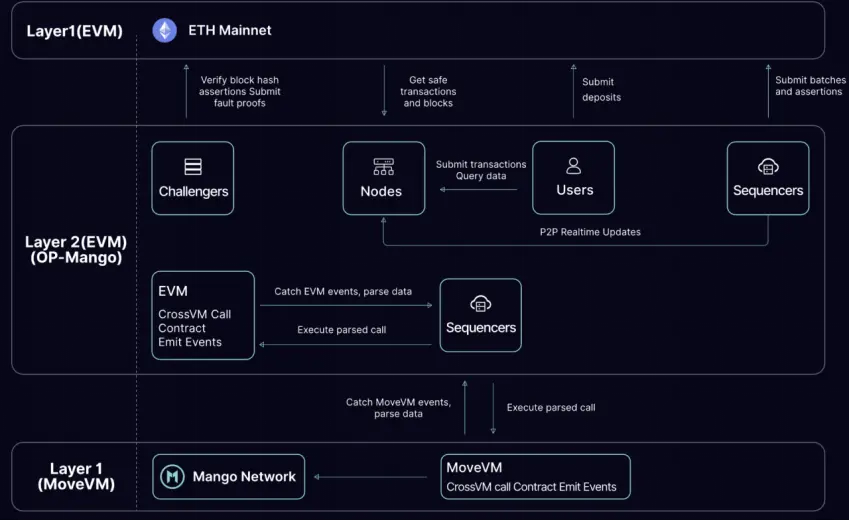
Multi-Virtual Machine Parallelism and Cross-Chain Technology Integration
Synergistic effects of parallel execution, cross-chain communication, and Layer 2 scaling
- Multi-Virtual Machine Parallelism: MoveVM optimizes asset management and contract logic, while EVM combines with OP-Mango to support cross-chain contracts.
- Layer 2 Scaling: Transactions in Layer 2 are periodically submitted to the mainnet, ensuring security through assertion mechanisms.
- Inter-Virtual Machine Communication: Smart contract events are captured and serialized for transmission, achieving interoperability between EVM and MoveVM contracts.
- Cross-Chain Asset Management: Assets are synchronized to MoveVM through OP-Mango after EVM operations, ensuring bidirectional settlement consistency.
Cross-Chain Communication between MoveVM and EVM
Mango Network uses the OP-Mango second-layer network to process transactions through EVM compatibility and P2P synchronization. The sorter orders transactions and synchronizes Ethereum states through assertions. Its cross-chain contracts achieve interoperability and secure settlement between EVM and MoveVM, optimizing the developer experience.
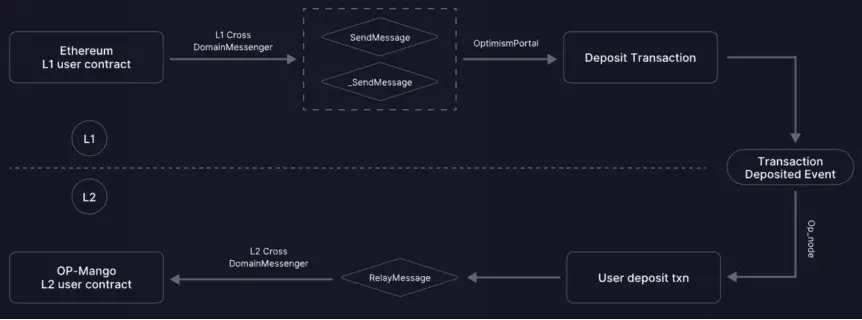
Commentary
Mango's modular blockchain can possess sovereignty like Layer 1, capable of resisting hacking attacks and being upgradable. The Mango modular blockchain can be applied to new blockchains, simplifying the component offloading process, reducing deployment time and costs. The Mango public chain combines zero-knowledge proof technology, allowing information to be disclosed without revealing the information itself. Through validity proofs, nodes can verify transactions, reducing confirmation times and increasing network throughput. MgoDNS is a distributed domain name solution based on cross-chain protocols, providing domain name and domain data analysis services. It helps businesses and individual users manage valuable on-chain data more efficiently, securely, and conveniently, and participate in digital asset transactions.
The Mango client utilizes mechanisms such as resource allocation, distributed locks, and sorting to enhance system performance, ensuring data consistency and parallelism. It achieves multifunctional operations based on efficiency, security, scalability, and quasi-linear capacity increases.
1.2. Analysis of Fluent, a hybrid execution network led by Polychain Capital that links EVM, SVM, and WASM chains
Introduction
Fluent is the first hybrid execution network—a Layer 2 framework for Ethereum that integrates smart contracts based on Wasm, EVM, and (soon-to-be-supported) SVM, forming a unified execution environment.
Smart contracts targeting different virtual machines can directly call each other on Fluent. Fluent is currently in the public development network phase, supporting applications composed of Solidity, Vyper, and Rust contracts.
Fluent's unique value proposition lies in its ability to:
- Simulate execution environments (EEs) for multiple virtual machines (VMs),
- Achieve real-time composability of smart contracts related to different virtual machines (such as EVM, SVM, Wasm, etc.),
- Support contracts written in various programming languages (such as Solidity, Rust, etc.),
- Operate within a shared state execution environment.
Fluent supports atomic composability between applications targeting different virtual machines, as well as "hybrid" applications composed of mixed and matched smart contracts. Interactions between different types of contracts supported by the network occur in the background, being both atomic and real-time.
How does Fluent support hybrid execution?
On Fluent, the functionalities of EVM, SVM, and Wasm are "merged" together at the execution layer. This is achieved through rWasm—a low-level intermediate representation (IR) that serves as Fluent's virtual machine. rWasm is essentially a state verification function responsible for representing every operation in Fluent's execution layer. Fluent simulates the behavior of EVM, SVM, and Wasm, which are compiled into rWasm for execution. This ensures compatibility and smooth interaction between these different systems, and from the perspective of zk proofs, it is optimal since only one state transition needs to be proven (unlike multi-VM solutions that require proving multiple state transitions). Fluent's hybrid design is also scalable—more virtual machines can be represented in the future through dedicated AOT/JIT compilers.
Hybrid Execution vs. Multi-Virtual Machine
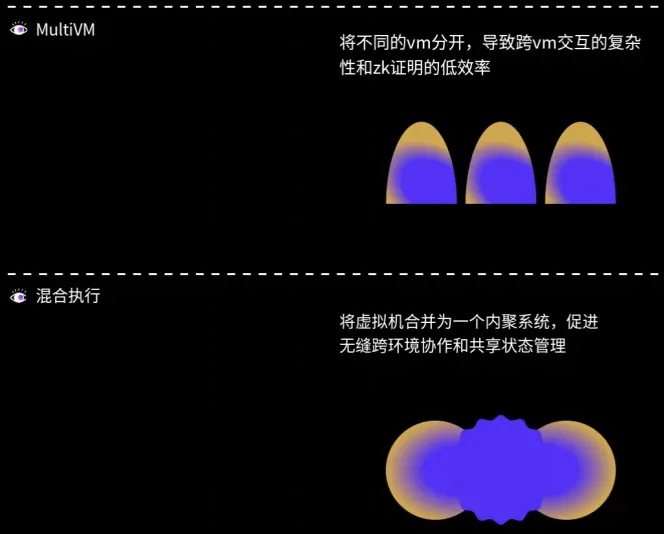
MultiVM is an alternative virtual machine (altVM) that uses multiple independent virtual machines within the same network. Each virtual machine operates independently, suitable for different programming languages or execution environments. Maintaining independent virtual machines introduces complexity, especially in state synchronization and inter-VM interaction. This can lead to fragmentation in developer and user experiences, as interactions between different environments require additional coordination. In contrast, hybrid execution (Blended Execution) offers a more integrated approach than multiVM. Hybrid execution does not maintain independent virtual machines for interaction but merges different virtual machines into a unified execution environment. This allows multiple virtual machines to share the same state and execute seamlessly within the same framework. From the perspective of zk proofs, this is also optimal since only one state transition needs to be proven. In reality, the main difference lies in the degree of integration.
What are hybrid applications?

This enables developers to write different parts of applications using the most suitable language and execution environment for each component, thereby improving performance, flexibility, and usability.

Commentary
Based on the information currently available, Fluent L2 will support two types of applications: shared and dedicated.
- Shared Applications: These smart contract applications share state within Fluent's execution environment. All applications shared on Fluent L2 are written in real-time, even across different VM targets and programming languages (e.g., Rust and Solidity).
- Dedicated Applications: These applications are customizable, independent state machines that can leverage Fluent for evidence aggregation and validation. Developers can customize independent application runtimes, modular layers (e.g., DA, sequencing), and more.
1.3. What is Kaito, which is live on top CEXs like Binance and Coinbase, and can this crypto information retrieval tool make breakthroughs?
Introduction
Kaito is a cryptocurrency search engine powered by ChatGPT, aimed at revolutionizing crypto research and investment through artificial intelligence. Kaito utilizes internal AI technology to organize and structure terabytes of unstructured information in the crypto space, making it easily accessible for investors, researchers, developers, and the public.
Three Major Products
- Portal
This is the ultimate AI-driven Web3 information platform designed to transform terabytes of unstructured information into actionable insights.
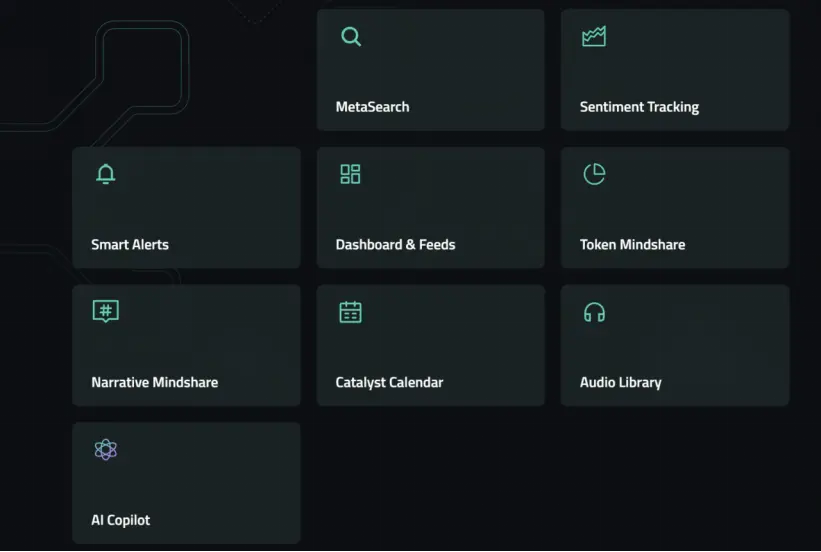
- Instant Insight Search
Search any token, topic, or trend through thousands of high-quality Web3 sources in seconds to obtain instant insights.
- Sentiment Analysis
Gain deep insights into the factors influencing significant sentiment changes through Kaito's AI-driven analysis, and easily interpret complex sentiment data for valuable insights.
- Real-time Smart Alerts
Set fully customizable real-time smart alerts for any project, topic, keyword, event, sentiment change, etc., making monitoring unprecedentedly simple. - Customized Watchlists and Dashboards
Track all the latest news, governance proposals, discussions, sentiment changes, upcoming catalysts, and events covering any token, project, or topic through customized watchlists. - Monitor and Benchmark Project Awareness
Quantitatively and objectively monitor and benchmark changes in awareness within the market or specific fields. - Track Narrative Rotation
Systematically track narrative rotation to understand the momentum of existing narratives and identify upcoming new narratives in advance. - Catalyst Calendar
Real-time tracking of events and catalysts for over 2000 crypto tokens, including product launches, tokenomics changes, unlocks, TGEs, governance votes, etc. - Audio Library
Access all podcasts and meeting notes transcribed by Kaito's voice-to-text model optimized for Web3, providing TLDR summaries for easy access to key information. - Smartest Crypto AI Assistant
The smartest crypto AI assistant with the most comprehensive real-time information, boosting your work efficiency several times over.
- API
Kaito's API allows you to systematically access our unique internal datasets, helping you make more informed decisions in Web3.
Kaito's API services target funds, project teams, research institutions, exchanges, etc., providing you with real-time access to the highest quality and most comprehensive knowledge datasets, as well as quantifiable social metrics across our unique database.
- Seamless Integration Easily integrate multiple Kaito features for systematic decision-making, monitoring, and analysis. Our API ensures you can access rich information at any time.
- Unique Metrics and Data Sources Access unique datasets to stay updated with market dynamics. Our industry-leading methodologies, coverage, and data reliability help you make informed decisions and stay at the forefront.
- Comprehensive Coverage Covering 2000 tokens and a wide range of Web3 data sources, our API provides unparalleled access, including the latest and historical data, to help you make informed decisions in the evolving Web3 space.
- Yaps
A unique "influencer" ranking and their interconnection network, unlike other platforms tracking influencer consultations, Kaito's Yaps product adds a clear path of how a tweet can influence from the initiator to all mentioned users, allowing users to trace back the origin, process, and conclusion of an impactful tweet.
This feature is a first in the industry, enabling users to accurately capture different influencers' perspectives on a matter or market.
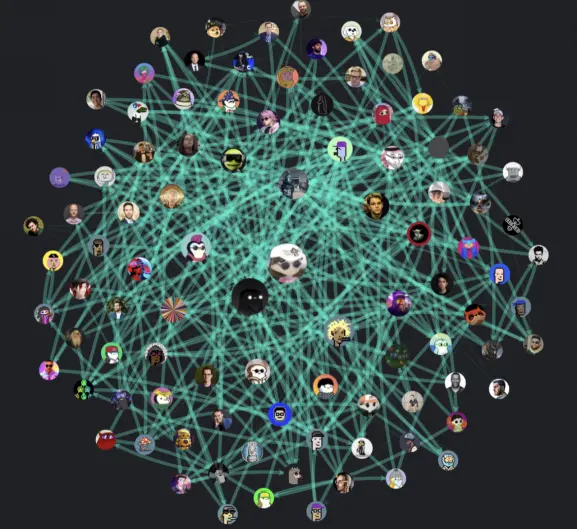
Commentary
Kaito is a next-generation Web3 information platform that indexes a wide range of Web3 content that is difficult to access through traditional search engines. This content includes social media, governance forums, research reports, news, podcasts, meeting notes, and more. By leveraging advanced AI technology, Kaito redefines how users discover and interact with blockchain-related information.
The team is committed to innovating the way Web3 information is accessed. By indexing thousands of high-quality Web3 sources, Kaito transforms terabytes of unstructured information into searchable and actionable insights, helping users make more informed decisions.
2. Detailed Overview of Projects to Watch This Week
2.1. Nvidia-backed, detailed analysis of the AI Gaming project GamerBoom, co-invested by Solana and the Web3 portal protocol Mask
Introduction
GamerBoom is an incentive layer and data mining protocol based on mainstream Web2 games, utilizing an AI-driven data labeling system. It aims to revolutionize gaming culture and economics by empowering players to control their digital lives.
The Gaming Portal (GamerBoom application) is an application overlaying Web2 games, serving as a zero-barrier entry point for players in the ecosystem, connecting Web2 gamers with the Web3 universe. Its goal is to smoothly integrate Web3 incentive mechanisms while maintaining the immersive experience of Web2 games. With innovative gamified design, the Gaming App aims to enhance player engagement and encourage active participation in various ecosystem activities.
Technical Analysis
- Ecosystem Overview
The GamerBoom team is dedicated to building not just a gaming platform; they are establishing an open gaming ecosystem that allows players to thrive, innovate, and lead the arrival of a new era of digital gaming. Join the team to pave the way for the future, where gaming and blockchain technology are closely intertwined, creating a world where every player can invest in their digital lives.
GamerBoom's architecture is meticulously designed, consisting of three core layers:
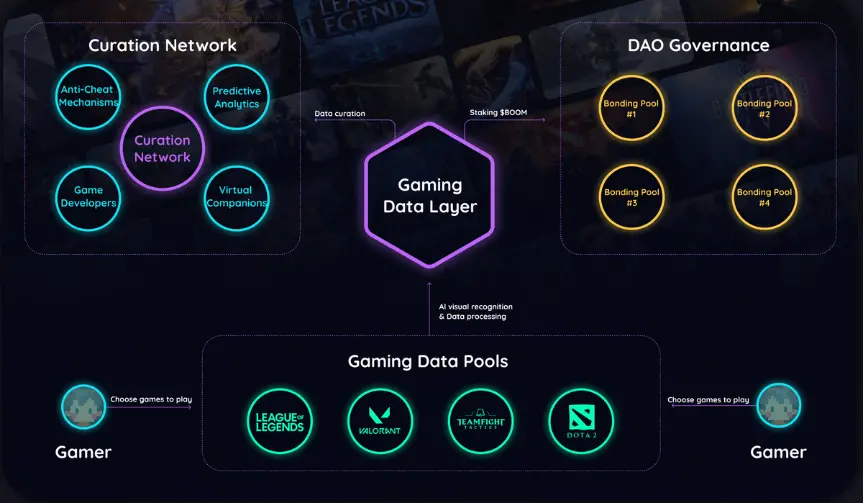
Data Mining Layer
This foundational layer is a gamified incentive layer built on top of Web2 games, aimed at data mining. It provides real-time tracking, feedback, and scoring of in-game player behavior. The system implements an AI tagging system to handle in-game actions, decision patterns, and engagement.
Future plans include incentivizing users to share game-related social data, enriching the dimensions of game data.
Game Data Layer
At this layer, the processed data shared by players is provided to tuning nodes for training AI agents. All AI agents automatically generate a unique binding pool based on the bonding curve. Shareholders select high-quality AI agents from the sharing market and recommend them by adding liquidity to their binding pools. A portion of the income generated by AI agents is automatically shared with shareholders. Professional shareholders can also utilize player data and AI agents to develop applications and use cases that better meet commercial needs, thereby enhancing profitability.
Application Layer
The application layer is a derivative layer of the game data layer, adaptable to various use cases, including the upcoming PVP exchange. It utilizes multidimensional real game data to serve multiple purposes, such as advising game developers, training game AI, creating applications based on game behavior, or modifying games, along with other potential use cases.
- AI-Driven Data Layer
In GamerBoom's technical solution, the aim is to utilize a combination of lightweight local models and cloud-based GPT (Generative Pre-trained Transformer) models to facilitate efficient and accurate image recognition tasks in the gaming environment. This hybrid approach allows GamerBoom to balance speed, cost, and complexity, ensuring optimal performance while effectively managing resource utilization.
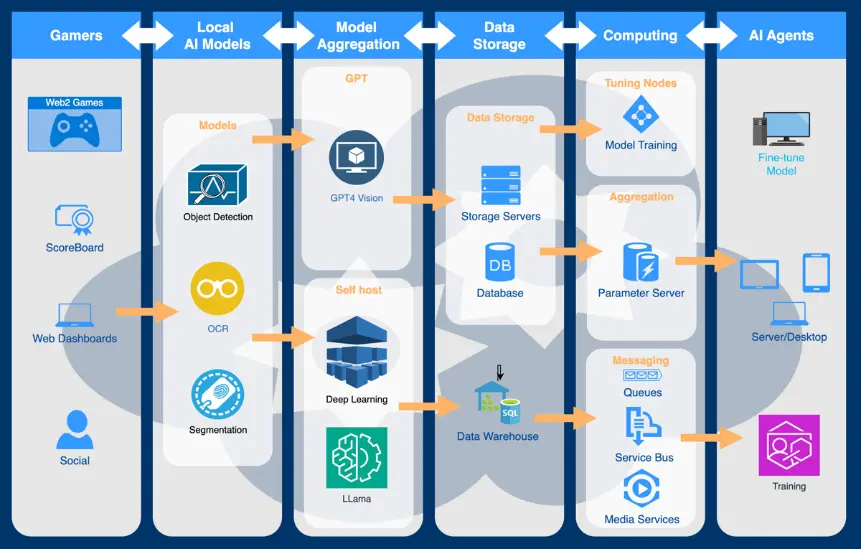
AI System Architecture Local Model Architecture
Our local model architecture consists of a set of lightweight models directly deployed in the client's gaming application. These models are designed to perform quick and simple image recognition tasks, providing rapid responses without imposing significant computational burdens.
Hybrid Model Integration
Our hybrid model integration strategy combines the advantages of local models with the powerful capabilities of GPT in handling complex image recognition tasks. This approach involves seamless communication between the client-side local models and the cloud-based GPT models, ensuring comprehensive coverage and accuracy. The integration process includes the following steps:
- Local Model Invocation: The local model continuously analyzes the game screen at regular intervals (typically every 100 milliseconds), capturing relevant frames.
- Simple Task Resolution: The local model quickly processes simple image recognition tasks, providing immediate responses suitable for direct tasks that do not require extensive computational resources.
- Complex Task Recognition: For tasks beyond the local model's capabilities, such as recognizing complex game elements or scenes, the client application forwards the relevant frames to the cloud-based GPT model for further analysis.
- AI Processing: The AI model employs advanced deep learning techniques, including image recognition and OCR, to accurately interpret the forwarded frames and generate appropriate responses.
- Response Integration: Upon receiving the response from the GPT model, the client application seamlessly integrates the results into the ongoing gaming experience, providing relevant insights or actions based on the processed information.
Our hybrid technical solution offers multiple advantages and considerations:
Advantages:
- Speed and Efficiency: The use of local models ensures quick responses for simple tasks, reducing latency and enhancing the overall user experience.
- Cost Optimization: By delegating routine tasks to lightweight local models and only resorting to the cloud-based GPT model for complex scenarios, we optimize computational costs while maintaining high accuracy.
- Scalability: The modular architecture facilitates expansion, allowing for easy addition of new models or enhancement of existing ones to adapt to the evolving gaming environment.
- Accuracy and Flexibility: The combination of local models and GPT ensures accuracy and flexibility in image recognition across diverse gaming environments, guaranteeing robust performance in various scenarios.
- AI Agents as Assets
AI agents as assets (AIaaA) represent a paradigm shift in the application and utilization of artificial intelligence across various fields. With the integration of advanced data mining techniques and the game data layer, AI agents are at the forefront of innovation, offering numerous potential applications and promising directions for future development. An Initial Agent Offering (IAO) platform will be launched to accelerate the adoption of AI agents in the market.
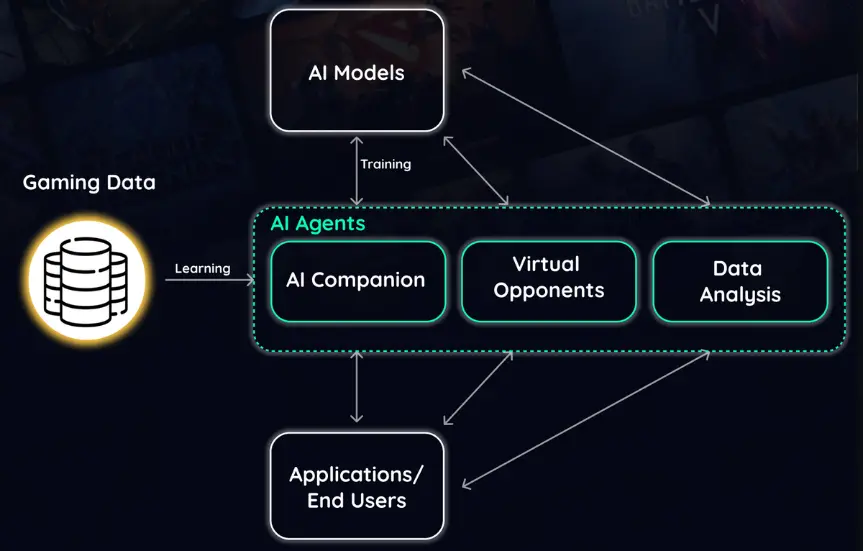
Agent Creators
Agent creators utilize processed game data to train AI agents for various applications and purposes, not just direct trading and monetization of game data.
Once trained, these AI agents will directly serve businesses and individual users. These services include but are not limited to API data stream models or chat dialogue models. Agent creators challenge and compete with each other to improve the performance and services of AI agents.
- Potential Applications of AI Agents
Personalized Gaming Experience: AI agents can analyze vast amounts of game data collected from players to create highly personalized gaming experiences. From dynamically adjusting difficulty levels to providing tailored in-game content recommendations, AI agents enhance player engagement and satisfaction.
Predictive Analytics in Gaming: By leveraging machine learning algorithms, AI agents can predict player behaviors and preferences, facilitating targeted marketing strategies and content development. This predictive capability enables game developers to anticipate trends and adjust products in real-time, maximizing revenue potential.
Virtual Companions for Gamers: AI agents can act as virtual assistants for gamers, providing real-time guidance, tips, and strategies tailored to individual gaming styles and skill levels. Whether assisting with puzzles or offering tactical advice in multiplayer battles, AI assistants can enhance the gaming experience.
Anti-Cheat Mechanisms: AI agents play a crucial role in detecting and preventing cheating in games. By analyzing gameplay patterns and identifying anomalies, these agents help maintain fair competition and uphold the integrity of online gaming environments.
Content Moderation and Safety: AI agents equipped with natural language processing capabilities can monitor in-game communications to detect inappropriate or harmful content. By enforcing community guidelines and filtering toxic behavior, these agents contribute to creating a safer and more inclusive gaming environment.
- Future Development Potential
Cross-Industry Integration: Beyond gaming, AI agents have the potential to revolutionize multiple industries, including education, healthcare, and finance. By adapting their capabilities to different fields, these agents can facilitate personalized learning experiences, assist in medical diagnoses, and optimize financial decision-making processes.
Enhanced Human-Machine Collaboration: As AI technology continues to advance, AI agents will become more adept at collaborating with human users. Through natural language interfaces and intuitive interactions, these agents will seamlessly integrate into daily tasks, augmenting human capabilities and productivity.
Ethical and Responsible AI: As the autonomy and influence of AI agents increase, they must adhere to ethical principles and guidelines to ensure responsible behavior. Future developments will focus on achieving transparent and accountable AI systems that prioritize user privacy, fairness, and social welfare.
Continuous Innovation in AI Algorithms: The evolution of AI agents relies on the ongoing advancement of machine learning algorithms, including deep learning, reinforcement learning, and evolutionary computation. By pushing the boundaries of AI research, developers can unlock new capabilities and expand the potential applications of AI agents.
In summary, AI as a Service (AIaaS) represents a groundbreaking way to harness the power of artificial intelligence not only in gaming but also across other industries. With its diverse applications and limitless innovative potential, AIaaS heralds a future where intelligent agents play a central role in shaping our digital experiences and transforming various sectors.
- Open Sharing Network
GamerBoom also offers a decentralized curation network for user-generated AI agents within the ecosystem, consisting of a local curation market, application launch platform, and governance module. The liquidity-based curation network is a vital component of the GamerBoom ecosystem, providing a reliable and efficient value exchange mechanism and laying a solid foundation for future development.
For each AI agent, a binding pool based on a bonding curve will be created for liquidity-driven curation and promotion. Curators can add liquidity ($BOOM) for better promotion and earn profit shares by holding sharing tokens.
Throughout the network, all AI agents will be prioritized and recommended based on their liquidity rankings.
Liquidity participants in the binding pool (BLP token holders) also act as liquidity-based retail curators, significantly amplifying the influence of the assets they are associated with. Professional curators can also profit by building use cases and applications based on AI agents and player data.
This additional layer of liquidity allows intangible assets (datasets) to create unique binding pools, monetizing and tokenizing their influence and intrinsic value, earning transaction fee shares and network incentives.
Our innovative dynamic bonding curve provides an open, transparent, and efficient on-chain data curation mechanism, automatically distributing profits to data miners, tuning nodes, data curators, and data consumers. This approach makes the market more efficient and transparent, with token prices determined by the collective behavior of network participants.
Initial Bonding Curve
In the GamerBoom ecosystem, we set the initial value of the reserve ratio K to 1/3, while the value of m is determined when creating a binding pool for a specific asset. Through these settings, we can derive the price function for minting or burning BLP tokens (sharing tokens of the binding pool) in the asset binding pool as follows:
- Price Formula:

- Reserve Formula:

Dynamic Bonding Curve
GamerBoom adopts a dynamic bonding curve to coordinate the interests of data miners, data curators, and data consumers. If a dataset generates revenue across the ecosystem, a portion of the profits will be automatically added to the reserves of the binding pool.
Assuming the reserves increase from R0 to R0+ΔR, the reserve ratio K will increase from K0 to K0+ΔK, then:

If a user sells a total of N BLP tokens, causing the total supply to decrease from S0 to S0−N, the total amount of base currency A paid will be:

Based on the above formulas, we obtain:

When reserves are added at a certain position on the bonding curve, the reserve ratio K will increase (never exceeding 1). For users already holding N NLP tokens, this means they will sell more reserve tokens than before the reserves were added.
Summary
GamerBoom's advantages include allowing users to maintain their habits without adapting to new workflows by adopting UI/UX designs from popular launchers like Steam, Epic Games, and Wegame. By enhancing popular Web2 games through an AI-driven data tagging system, we smoothly aggregate game data through engaging and beneficial overlays. The introduction of bonding curves builds a sustainable, decentralized AI agent-driven gaming economy for billions of players worldwide.
Challenges faced include the need to balance local computing resources with cloud processing demands, requiring careful resource management to avoid performance degradation or excessive costs. Optimizing the integration between local models and GPT to minimize latency and ensure accurate results is crucial for maintaining the real-time nature of the gaming experience. Strong privacy and security measures are needed when handling sensitive game data (such as screen captures) to protect user information and prevent unauthorized access or misuse. Regular maintenance and updates of local and cloud models are necessary to ensure alignment with the evolving gaming environment and technological advancements.
3. Industry Data Analysis
1. Overall Market Performance
1.1 Spot BTC & ETH ETF
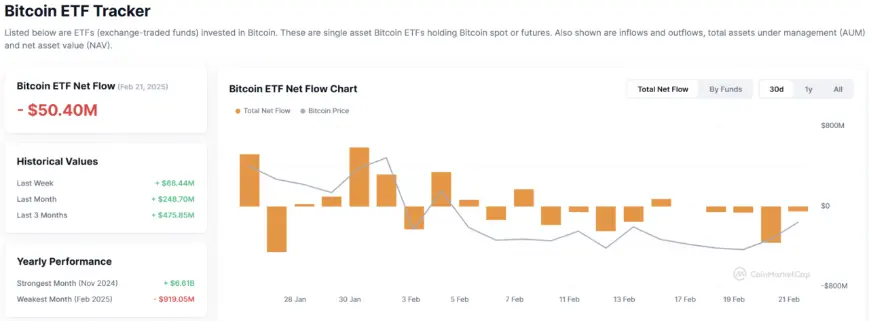
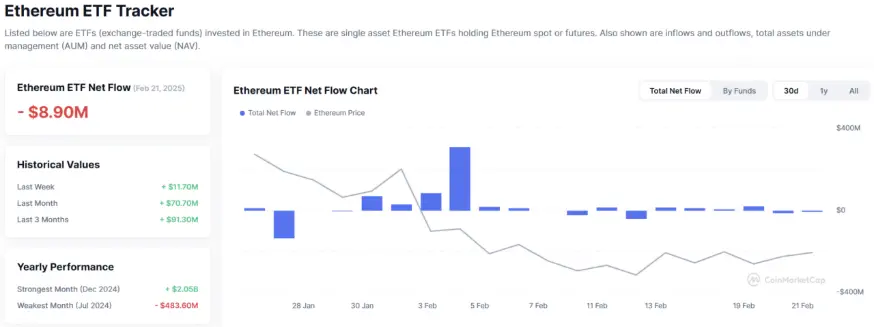
1.2. Spot BTC vs ETH Price Trends
BTC
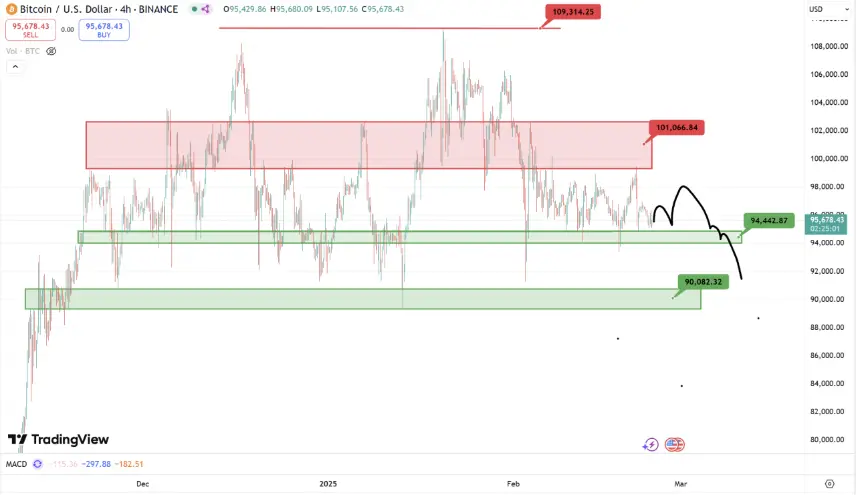
Analysis
Last week, BTC faced resistance as expected at the bottom of the $100,000 resistance zone. This week, the price is likely to continue testing the resistance around $98,000, but without a significant increase in trading volume, the likelihood of a downward test towards $95,000 is increasing. If it breaks below $94,000, attention should be directed towards the critical support level of $90,000. If it stabilizes in the $94,000 area or continues to consolidate around the $94,000 to $98,000 range, users are advised to be cautious and hold their spot positions while reducing contract trading.
ETH
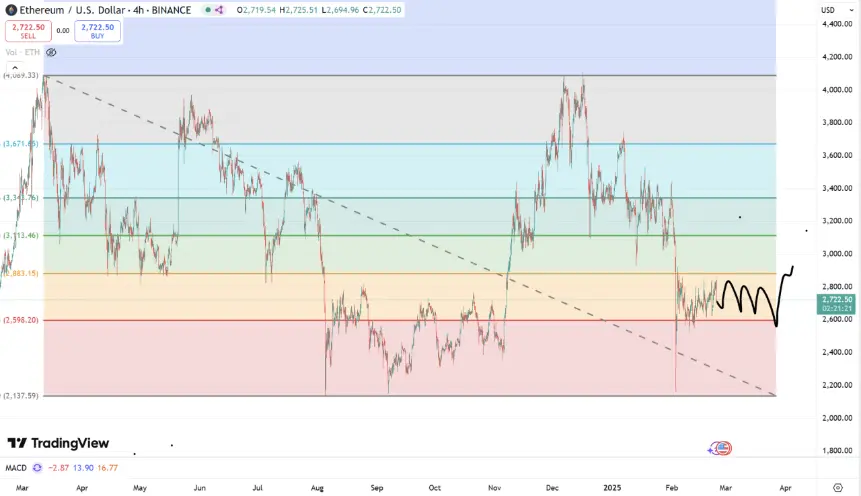
Analysis
ETH continued to oscillate in the $2600 to $2900 range along the Fibonacci retracement line last week, making the trend relatively easy to predict. If there is a stagnation pattern upon a rebound to around $2900, it indicates the end of a minor rebound, and the downward trend will continue. Support can still be monitored around $2600. It can be reasonably determined that if there are no significant fluctuations in the fundamentals, the probability of continuing to oscillate within the aforementioned range this week is high. It is not advisable to hold a long-term bearish view until it breaks below $2520.
1.3. Fear & Greed Index
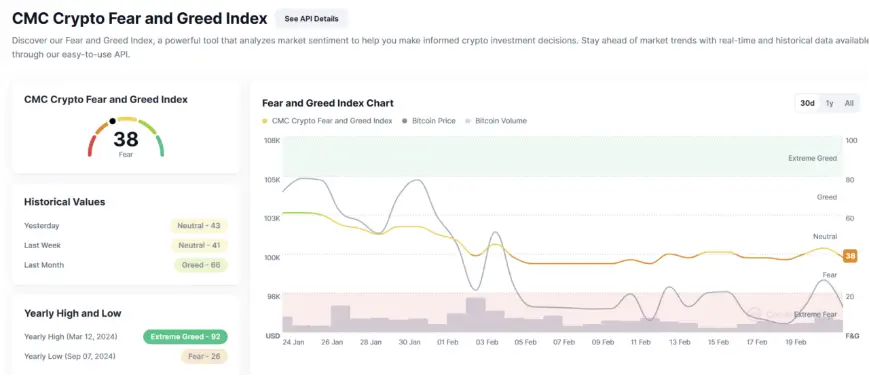
From February 17 to February 23, 2025, the cryptocurrency fear and greed index dropped from 47 to 38, indicating a shift in market sentiment from neutral to fear. This suggests that investors have become more cautious during this period. Factors that may have contributed to this change include:
- Market Volatility: Increased price fluctuations may lead to rising uncertainty among investors, causing market sentiment to turn to fear.
- Market Correction: A decline in cryptocurrency prices may cause investors to worry about the future direction of the market, triggering fear sentiment.
- Negative News: Reports of security breaches, exchange hacks (such as the Bybit theft incident), or other adverse events may undermine investor confidence.
2. Public Chain Data
2.1. BTC Layer 2 Summary

Analysis
From February 17 to February 23, 2025, several significant developments occurred in the Bitcoin Layer 2 solutions space, highlighting the growing focus on enhancing Bitcoin's scalability and efficiency.
Key Developments:
- Nic Carter and David Seroy Discuss Bitcoin Rollups: On February 17, 2025, Nic Carter had a discussion with David Seroy from Strata/Alpen about Bitcoin Rollups and the upcoming "Bitcoin Layer 2 Season." This conversation emphasized the increasing attention on Layer 2 solutions aimed at improving transaction efficiency and scalability on the Bitcoin network.
- Market Reaction: Following the announcement of progress in Bitcoin Layer 2 solutions, the price of Bitcoin saw a slight increase. On February 17, 2025, at 12:00 UTC, the price of Bitcoin rose from $65,100 at 9:00 UTC to $65,420. Additionally, trading volume increased by 10% within three hours of the announcement, reaching 23.5 million BTC, indicating high trader interest.
- Stacks Launches Nakamoto Upgrade: Stacks, a leading Bitcoin Layer 2 platform, announced the launch of the Nakamoto upgrade, aimed at improving transaction speed and security. This upgrade is expected to enhance the Bitcoin economy by supporting faster and more secure applications and smart contracts.
These developments reflect the increasing focus on enhancing Bitcoin's scalability and efficiency through Layer 2 solutions, with related discussions and technological advancements receiving significant attention during this period.
2.2. EVM & Non-EVM Layer 1 Summary
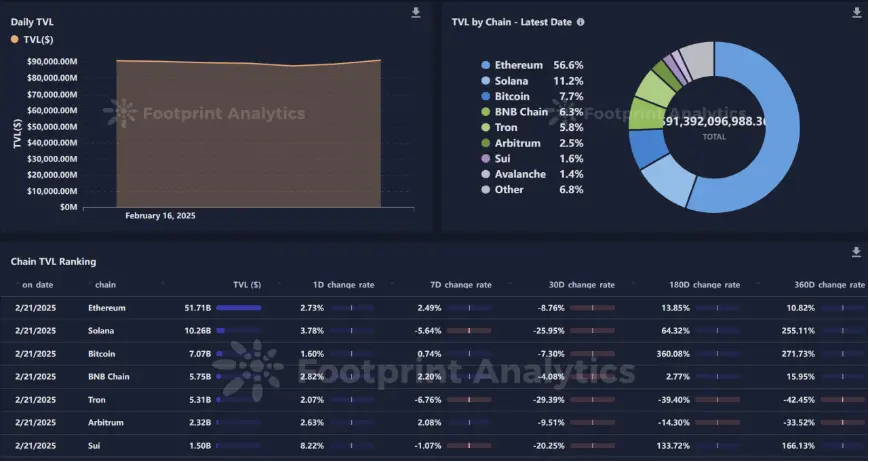
Analysis
From February 17 to February 23, 2025, several important developments occurred in the EVM-compatible and non-EVM Layer 1 blockchain space:
EVM-Compatible Layer 1 Blockchains:
- Monad Testnet Launch: Monad, a high-performance EVM-compatible Layer 1 blockchain, launched its testnet on February 19. The network aims to achieve a speed of over 10,000 transactions per second through parallel execution, striving to compete with Ethereum and Solana in terms of speed and scalability. Developers can now participate in the testnet using new browsers and wallets and obtain testnet tokens from the Monad faucet.
- Orderly Integration with Monad: On February 19, Orderly, a permissionless liquidity layer, integrated its cross-chain liquidity infrastructure with Monad. This move provides deep liquidity across multiple blockchains for the Monad ecosystem, including decentralized exchanges, enhancing the user trading experience.
- Sonic Labs Performance Milestone: Sonic Labs, an EVM Layer 1 blockchain, reported that it has processed over 25 million transactions, attracted 758,000 unique addresses, and deployed 58,000 smart contracts. The network operates at a speed of 10,000 transactions per second, with low costs and rapid ecosystem development.
Non-EVM Layer 1 Blockchains:
- Aptos Proposal for Aave Integration: The Aptos Foundation proposed integrating the Aave protocol v3 into its mainnet, marking the first deployment of the Aave liquidity protocol on a non-EVM blockchain. The proposal seeks community feedback and aims to extend Aave's influence beyond EVM-compatible networks.
- Entangle's Solana Integration: Entangle expanded its cross-chain support by integrating Solana into its Photon messaging protocol. This integration enables trustless cross-chain messaging between EVM and non-EVM Layer 1 networks (such as Solana), facilitating secure interactions between different blockchain ecosystems.
2.3. EVM Layer 2 Summary

Analysis
From February 17 to February 23, 2025, several significant developments occurred in the Ethereum Virtual Machine (EVM) Layer 2 ecosystem:
Berachain Mainnet Launch on Bitget Wallet with Airdrop Rewards: On February 7, 2025, the Berachain mainnet launched on the Bitget wallet, allowing users to receive additional rewards through the BERA airdrop.
Ramp Network Launches Direct Withdrawal Feature for Ethereum Layer 2 via MetaMask: On January 22, 2025, Ramp Network announced that users can now sell cryptocurrencies directly from Ethereum Layer-2 networks through MetaMask.
SOON Raises $22 Million through NFT Sales for SVM-Driven Ethereum Layer 2: In January 2025, the Solana Optimistic Network (SOON) raised $22 million through NFT sales for its Ethereum Layer-2 network based on the Solana Virtual Machine (SVM).
4. Macroeconomic Data Review and Key Data Release Points for Next Week
The University of Michigan's consumer confidence index fell sharply from 71.7 in January to 64.7 in February, marking the lowest level since August 2024. Consumer confidence in the future economic situation has significantly weakened.
The latest minutes from the Federal Reserve's meeting released last week indicated that officials believe inflation remains slightly above target, and there is uncertainty in the economic outlook, but the risks to employment and inflation targets are roughly balanced. The market is closely watching the upcoming core PCE data this week to further assess the direction of the Federal Reserve's monetary policy.
Important macroeconomic data points for this week (February 24-28) include:
February 26: U.S. EIA Crude Oil Inventory for the week ending February 21
February 27: U.S. Initial Jobless Claims for the week ending February 22
February 28: U.S. January Core PCE Price Index Year-on-Year
5. Regulatory Policies
The week saw significant events in the cryptocurrency industry, including Argentine President Milei attempting to clarify the relationship with LIBRA and Bybit being hacked for approximately $1.5 billion in cryptocurrencies, highlighting the urgency and necessity for the cryptocurrency industry to explore appropriate regulatory measures. Following the relaxation of regulatory pressure in the U.S., Hong Kong has timely introduced a regulatory roadmap, clearly intending to establish a friendly crypto center, but how to advance this remains to be seen.
United States
The U.S. Securities and Exchange Commission (SEC) announced the establishment of the Cyber and Emerging Technologies Unit (CETU) to protect retail investors. Laura D'Allaird has been appointed as the head of the new unit, which replaces the previous Crypto Assets and Cyber Unit and consists of about 30 fraud experts and attorneys from various SEC offices. This new unit will complement the work of the crypto working group led by Commissioner Hester Peirce. Importantly, the new unit will also allow the SEC to deploy enforcement resources wisely. CETU will be responsible for combating fraud involving blockchain technology and crypto assets, as well as improper disclosures related to public issuers concerning cybersecurity.
Nigeria
According to Reuters, court documents show that Nigeria has filed a lawsuit seeking to compel Binance to pay $79.5 billion to compensate for economic losses caused by its operations in the country and to pay $2 billion in back taxes. Previously, Binance stated that it is working with the Nigerian Federal Inland Revenue Service to resolve potential historical tax liabilities.
India
According to CoinDesk, the Indian Enforcement Directorate (ED) revealed that India has seized approximately $190 million in cryptocurrencies, cash, and a Lexus car in the investigation of the BitConnect fraud case. BitConnect founder Satish Kumbhani has been wanted in both India and the U.S. since 2023.
Hong Kong, China
On February 19, the Hong Kong Securities and Futures Commission (SFC) released a new regulatory roadmap for virtual assets, known as the "A-S-P-I-Re" roadmap, aimed at enhancing the security, innovation, and growth of Hong Kong's virtual asset market. The roadmap consists of five pillars: Access, Safeguards, Products, Infrastructure, and Relationships.
免责声明:本文章仅代表作者个人观点,不代表本平台的立场和观点。本文章仅供信息分享,不构成对任何人的任何投资建议。用户与作者之间的任何争议,与本平台无关。如网页中刊载的文章或图片涉及侵权,请提供相关的权利证明和身份证明发送邮件到support@aicoin.com,本平台相关工作人员将会进行核查。




